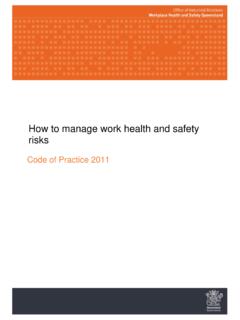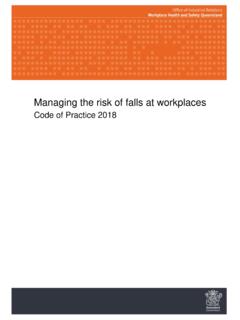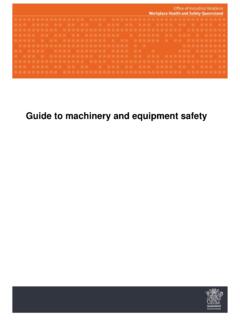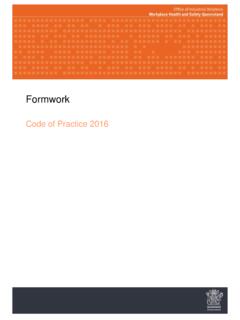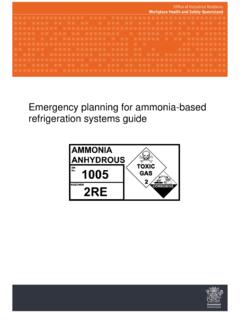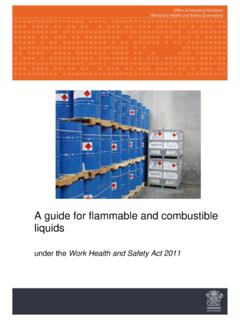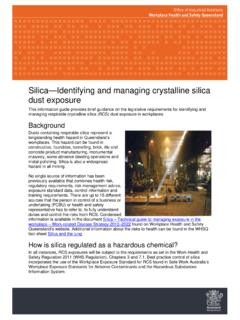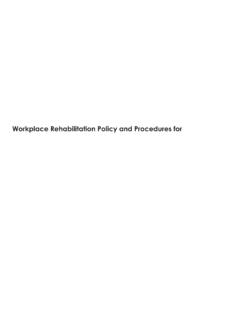Transcription of Excavation work Code of Practice 2021
1 Excavation work Code of Practice 2021. PN12677. ISBN Creative Commons This copyright work is licensed under a Creative Commons Attribution-Noncommercial International licence. To view a copy of this licence, visit In essence, you are f ree to copy, communicate and adapt the work f or non-commercial purposes, as long as you attribute the work to Saf e Work Australia and abide by the other licence terms. Excavation work Code of Practice 2021 Page 2 of 62. Contents Contents ..3. Foreword ..4. 1. Introduction ..5. What is Excavation work? 5. Who has health and safety duties in relation to Excavation work? 5. What is involved in managing risks associated with Excavation work? 8. Information, training, instruction and supervision 11.
2 2. The risk management process .. 12. Identifying the hazards 12. Assessing the risks 13. Controlling the risks 14. Maintaining and reviewing control measures 15. 3. Planning the Excavation work .. 16. Principal contractor for a construction project 16. Designers 17. Safe work method statements 17. Asbestos licensing 19. Adjacent buildings or structures 21. Essential services 22. Securing the work area 24. Emergency plan 24. 4. Controlling risks in Excavation 26. Excavated material and loads near excavations 27. Plant and equipment 29. Powered mobile plant 30. Falls 34. Using explosives 36. Atmospheric conditions and ventilation 36. Manual work 37. 5. Excavation methods .. 38. Trenching 38. tunnelling 39. Shafts 40. 6. Preventing ground 42.
3 Ground conditions 43. Benching and battering 44. Shoring 46. Removal of shoring supports 54. Shields and boxes 54. Other ground support methods 56. Regular inspection 56. Appendix A Glossary .. 57. Appendix B References and other information sources.. 62. Excavation work Code of Practice 2021 Page 3 of 62. Foreword This Code of Practice on how to manage the risks associated with Excavation work is an approved code of Practice under section 274 of the Work Health and Safety Act 2011. (the WHS Act). An approved code of Practice is a practical guide to achieving the standards of health, safety and welfare required under the WHS Act and the Work Health and Safety Regulation 2011. (WHS Regulation). Under section 26A of the WHS Act duty holders must comply with an approved code of Practice or follow another method, such as a technical or industry standard, if it provides an equivalent or higher standard of work health and safety than the standard required in this code.
4 A code of Practice applies to anyone who has a duty of care in the circumstances described in the code. In most cases, following an approved code of Practice would achieve compliance with the health and safety duties in the WHS Act, in relation to the subject matter of the code. Like regulations, codes of Practice deal with particular issues and do not cover all hazards or risks that may arise. The health and safety duties require duty holders to consider all risks associated with work, not only those for which regulations and codes of Practice exist. Codes of Practice are admissible in court proceedings under the WHS Act and WHS. Regulation. Courts may regard a code of Practice as evidence of what is known about a hazard, risk or control and may rely on the code in determining what is reasonably practicable in the circumstances to which the code relates.
5 An inspector may refer to an approved code of Practice when issuing an improvement or prohibition notice. This may include issuing an improvement notice for failure to comply with a code of Practice where equivalent or higher standards of work health and safety have not been demonstrated. Scope and application This Code is intended to be read by a person conducting a business or undertaking (PCBU). It provides practical guidance to PCBUs on how to manage health and safety risks associated with Excavation work. The guidance in this Code is relevant to Excavation contractors as well as PCBUs who have management or control of workplaces where Excavation work is carried out, for example principal contractors. This Code may be a useful reference for other persons interested in the duties under the WHS Act and the WHS Regulation.
6 This Code applies to all workplaces covered by the WHS Act where Excavation work is carried out and where Excavation work products and equipment are used and stored. How to use this Code of Practice This Code includes references to the legal requirements under the WHS Act and the WHS Regulation. These are included for convenience only and should not be relied on in place of the full text of the WHS Act or the WHS Regulation. The words must', requires' or mandatory' indicate a legal requirement exists that must be complied with. The word should' is used in this Code to indicate a recommended course of action, while may' is used to indicate an optional course of action. Excavation work Code of Practice 2021 Page 4 of 62. 1.
7 Introduction Excavation collapses are particularly dangerous. They can occur quickly, limiting the ability of workers and others to escape, especially if the collapse of a trench, tunnel or shaft is extensive. The speed of an Excavation collapse increases the risk associated with Excavation work. The consequences are significant falling earth can bury or crush a person in its path. This can result in death by suffocation or internal crush injuries. What is Excavation work? Excavation work means work to make an Excavation or to fill or partly fill an Excavation . Excavation work commonly includes work involving the removal of soil or rock from a site to form an open face, hole or cavity, including trenches, shafts and tunnels.
8 Excavation work is generally carried out using tools, machinery or explosives. Requirements imposed under the WHS Act and the WHS Regulation relating to Excavation work do not apply to a mine, a bore to which a relevant water law applies, or a trench used as a place of interment. Work connected with an Excavation is a type of construction work'. Therefore, when carrying out Excavation work, the requirements relating to construction work must also be complied with. Construction work, including work connected with an Excavation carried out in or near: a shaft or trench with an excavated depth of greater than metres a tunnel is high risk construction work' for which a safe work method statement (SWMS) must be prepared. Other key terms relating to Excavation work are listed in Appendix A.
9 Who has health and safety duties in relation to Excavation work? Duty holders who have a role in managing the risks of Excavation work include: persons conducting a business or undertaking (PCBUs). designers, manufacturers, importers, suppliers and installers of plant, substances or structures officers. Workers and other persons at the workplace also have duties under the WHS Act, such as the duty to take reasonable care for their own health and safety at the workplace. A person can have more than one duty and more than one person can have the same duty at the same time. Early consultation and identification of risks can allow for more options to eliminate or minimise risks and reduce the associated costs. The main duties in relation to managing the risks of Excavation work are set out in Chapter 2.
10 Excavation work Code of Practice 2021 Page 5 of 62. Person conducting a business or undertaking WHS Act section 19. Primary duty of care A PCBU must eliminate risks arising from Excavation work, or if that is not reasonably practicable, minimise the risks , so far as is reasonably practicable. The WHS Regulation includes more specific obligations for PCBUs to manage the risks of hazardous chemicals, airborne contaminants and plant, as well as other hazards associated with Excavation work, including trenches. PCBUs have a duty to consult workers about work health and safety and may also have duties to consult, cooperate and coordinate with other duty holders. Principal contractors WHS Regulation section 293. Meaning of principal contractor WHS Regulation section 308.
